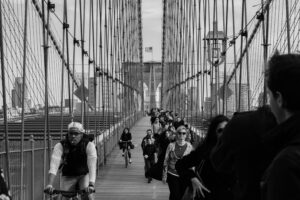Covid-19 has fundamentally changed how we do things- including getting to work, exercising, and spending time with family.
Outdoor activities such as hiking, biking, and walking have seen a boost as more people try to access the outdoors during quarantine.
Chicago and New York City have seen a spike in biking and walking to work since the pandemic.
Mayors and public officials are encouraging commuters to use alternate means of transportation to avoid crowded trains and buses to curb the spread of the virus.
Since shelter in place guidelines have gone into effect the cycling rate on bridges in New York City has more than doubled to 52%.
And Chicago’s bikeshare, Divvy which also saw their use double in early March is extending its 30 days of free rides to healthcare workers and also offering discounted $1 Divvy rides to the general public.

As more of us take advantage of the excellent summer weather under “shelter-in-place” guidelines, it’s essential to know how to best prepare for that hike, bike ride, or family walk.
Here are some essential tips for walking, running or biking during the COVID-19 pandemic.
1. Stay Well Hydrated
Make sure to bring a water bottle on your bike ride or hike. It’s important to stay hydrated especially if you are commuting in the summer. You are probably going to sweat and feel thirsty along the way.
Keeping your body well hydrated by replacing electrolytes and water lost due to sweat is essential, and can help to prevent mental and physical fatigue and boost immunity.
Hydrus’ single-serving packets are easy to take along while commuting to work or on family walks, bike rides, and hikes. And because they are sugar-free, Mom’s love using them as an alternative to sugary drinks.
“The single-serving packets are great! I keep them on hand every time we are out running errands or on a family outing for my son, who really likes them. It’s great to know that I can give him something which keeps him hydrated but is also sugar-free and good for him,” said Susan R. Palo Alto, California.
2. Maintain Proper Social Distancing
Whether you are going outside for a walk or a bike ride on the weekend or planning to commute to work, it’s crucial to maintain at least six feet of distance between you and other people. And while it’s probably safe to cycle and walk with family members or people you live with, you should avoid crowded streets, trails or paths, where maintaining six feet from others may be a challenge.
3. Practice “Good “Personal Hygiene
While the virus isn’t spread by sweat, items touched by too many people can pose a risk. And while there’s no 100% guarantee that you won’t the virus, there’s nothing wrong with maintaining proper personal hygiene.
If you are using a bike share or short-term bicycle, bring your own wipes to clean off handlebars, seat, and other commonly touched surfaces. It’s also a good idea to use hand sanitizer after you finish your ride and wash your hands as soon as possible.
Make sure you wipe down equipment such as gloves, sunglasses, helmets, wind jackets and watches after you’ve finished your walk, ride, or any rigorous exercise.
Lastly, you should take a shower and throw your dirty clothes into the wash as soon are you get home.
4. Proper Clothing and Equipment
If you are biking or walking to work daily, it’s essential to wear protective safety equipment such as a helmet and reflective clothing especially if you commute in the early mornings or after it’s dark.
Make sure that you know how to lock your bike securely. You may also want to carry a bicycle repair kit along on hikes and commutes.
5. Stay Alert & Put Away The Headphones
Whether you’ve just started biking or walking or you’re a triathlete, it’s essential to put away your headphones. Headphones hinder the ability to hear traffic and can cause serious accidents. Even if you are a veteran cyclist or runner, it’s crucial to remain aware of your environment.
Remember, many people have just started using these new routes, and could easily cause an accident. So stay alert and avoid distractions like cell phones, texts, and calls.
One of the ways to make sure that others people see you is by making direct eye contact with drivers and other people when crossing intersections.
It’s also helpful to use hand signals when turning so that others know where you are going.
Take the Hydrus Challenge Now and learn how Hydrus can help you stay hydrated while biking and walking to work or spending more time outdoors with the family!